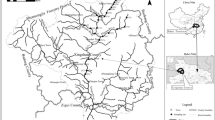Abstract
Changes in epilithic algal communities colonizing introduced substrata were determined in a stream polluted with oil refinery effluent at Digboi (Assam, India). The number of algal taxa was reduced but the growth of blue-green algae, particularly two species ofOscillatoria, was encouraged. Epilithic biomass (as chlorophylla) also declined at polluted stations. The algal community of the upstream station was markedly different from the community occurring just after the confluence of effluent; however, the differences were gradually reduced downstream, indicating improvement in water quality. Of the various criteria tested for possible relationships with the level of pollutants, species richness, Shannon diversity and biomass showed significant relationships. The study demonstrates the usefulness of algal criteria for monitoring oil pollution in running waters.
Similar content being viewed by others
References
American Public Health Association, 1985. Standard Methods for the Examination of Water and Wastewater, 16th Edn, APHA, Wash., D.C., 1268 pp.
Bott, T. L., K. Rogenmuser & P. Thorne, 1978. Effects of No. 2 fuel oil, Nigerian crude oil, and used crankcase oil on benthic algal communities. J. Envir. Sci. Hlth. A13: 751–779.
Cooper, J. M. & J. L. Wilhm., 1975. Spatial and temporal variation in productivity, species diversity, and pigment diversity of periphyton in a stream receiving domestic and oil refinery effluent. S. West Nat. 19: 413–428.
Dunstan, W. M., L. P. Atkinson & J. Natoli, 1975. Stimulation and inhibition of phytoplankton growth by low molecular weight hydrocarbons. Mar. Biol. 31: 305–310.
Federle, T. W., J. R. Vestal, G. R. Hater & M. C. Miller, 1979. Effects of Prudhoe bay crude oil on primary production and zooplankton in arctic tundra thaw ponds. Mar. Envir. Res. 2: 3–18.
Gaur, J. P. & H. D. Kumar, 1985. The influence of oil refinery effluents on the structure of algal communities. Arch. Hydrobiol. 103: 305–323.
Gray, J. S., 1979. Pollution-induced changes in populations. Phil. Trans. R. Soc., Lond. B. Bio. Sci. 286: 545–561.
Hanna, B. M., J. A. Hellebust & T. C. Hutchinson, 1975. Field studies on the phyto-toxicity of crude oil to subarctic aquatic vegetation. Verh. int. Ver. Limnol. 19: 2165–2171.
Hurlbert, S. H., 1971. The non-concept of species diversity: a critique and alternative parameters. Ecology 52: 577–586.
Levandowsky, M., 1972. An ordination of phytoplankton in ponds of varying salinity and temperature. Ecology 53: 398–407.
Mackinney, G., 1941. Absorption of light by chlorophyll solution. J. Biol. Chem. 140: 315–322.
McCauley, R., 1966. The biological effects of oil pollution in a river. Limnol. Oceanogr. 11: 475–486.
McIntire, C. D. & W. S. Overton, 1971. Distributional patterns in assemblages of attached diatoms in Yaquina estuary. Ecology 52: 758–777.
Minter, K. W.,1964. Standing crop and community structure of plankton in oil refinery effluent holding ponds. Ph.D. Thesis, Oklahoma State University.
O'Brien, P. Y. & P. S. Dixon, 1976. The effects of oils and oil components on algae: A review. Br. phycol. J. 11: 115–142.
Palmer, C. M., 1969. A composite rating of algae tolerating organic pollution. J. Phycol. 5: 78–82.
Pielou, E. C., 1966. The measurement of diversity in different types of biological collections. J. theor. Biol. 13: 131–144.
Rai, L. C., J. P. Gaur & H. D. Kumar, 1981. Phycology and heavy metal pollution. Biol. Rev. 56: 99–151.
Schultz, D. & L. D. Tebo, Jr., 1975. Boone Creek oil spill. In Proc. Conference on Prevention and Control of Oil Pollution, A.P.I., Washington; 583–588.
Shannon, C. E., 1948. The mathematical theory on communication. Bell System Technical J. 27: 379–423, 623–656.
Sheehan, P. J., 1984. Effects on community and ecosystem structure and dynamics. In P. J. Sheehan, D. R. Miller & G. C. Butler (eds), Effects of Pollutants at the Ecosystem Level, John Wiley & Sons, London: 51–100.
Snow, N. B. & B. F. Scott, 1975. The effect and fate of crude oil spilt on two arctic lakes. In Conference on Prevention and Control of Oil Pollution, USEPA, API, US Coast Guard: 527–534.
Soto, C., J. A. Hellebust & T. C. Hutchinson, 1977. Effect of naphthalene and aqueous crude oil extracts on the green flagellateChlamydomonas angulosa. I. Growth. Can. J. Bot. 53: 109–117.
Vandermeulen, J. H. & T. P. Ahern, 1976. Effect of petroleum hydrocarbons on algal physiology: Review and Progress report. In A. P. M. Lockwood (ed.), Effects of Pollutants on Aquatic Organisms, Cambridge Univ. Press, Cambridge: 107–125.
Author information
Authors and Affiliations
Rights and permissions
About this article
Cite this article
Singh, A.K., Gaur, J.P. Algal epilithon and water quality of a stream receiving oil refinery effluent. Hydrobiologia 184, 193–199 (1989). https://doi.org/10.1007/BF02392956
Received:
Revised:
Issue Date:
DOI: https://doi.org/10.1007/BF02392956




